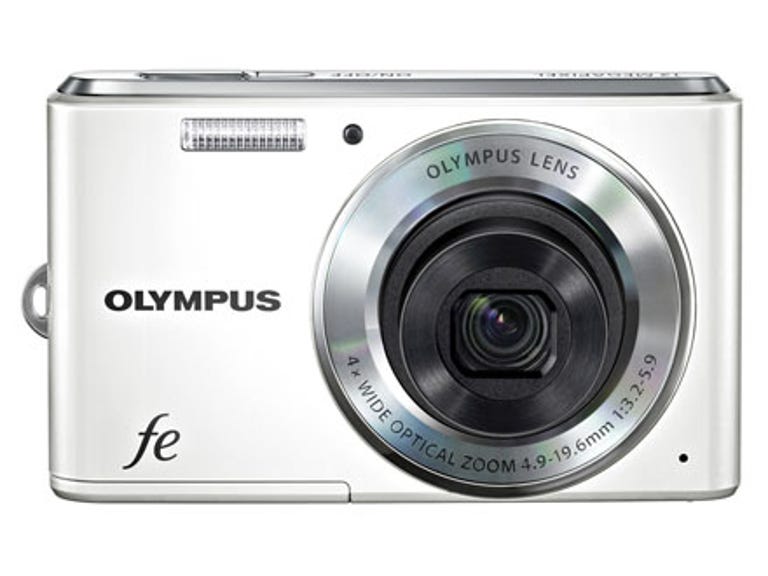 Why You Can Trust CNET
Why You Can Trust CNET Olympus FE-4050 review: Olympus FE-4050
The user-friendly Olympus FE-4050 is a marginally pared-down version of its big brother, the FE-5050, with slightly wider dimensions and a more plasticky build.
Want a digital camera that will deliver better quality than your camera phone, but don't have much spare cash? The FE-4050, the baby of three new compact cameras from Olympus, could be what you're looking for. Delivering 12-megapixel images rather than 14, the lightweight FE-4050 combines out-of-the-box usability with a smidgeon of style for a sub-£100 price point. It's available in a range of colours: starry silver, classic black, wine red and pure white.
The Good
The Bad
The Bottom Line
Wide boy
Feeling lightweight in the palm at just 112g with lithium battery and optional media card (92MB internal capacity provided), the camera powers up from cold in just over a second. It's a fast response that impresses as much as it did on the FE-5050. A greater degree of plastic in the build, disguised to an extent by a metallic silver finish, is no surprise given its low price. What is surprising is that the FE-4050 retains the more intriguing aspects of its marginally more expensive siblings -- the FE-5040 and FE-5050.

Like its peers, the FE-4050 shoehorns in a wide-angle optical zoom, which retracts within the body when the camera is inactive. In this case, the focal range offered is an equivalent 27-104mm (4x optical) rather than the marginally broader 26-130mm of the 5040 and 5050. This is supported, once again, by digital image stabilisation, boosting the shutter speed/ISO rather than shifting the sensor or lens elements to avoid blur. The camera is slightly fatter than the FE-5050 at 19.9mm, but nigh identical in width.
It could be Magic
Also shared with its FE brethren are six 'magic filters' -- fish eye, pop art, sketch, pinhole, and the brand-new soft focus and punk filters, as found on the FE-5050. The latter produces a crude, photocopied look with a pinky-purple colour wash. It might sound awful but it's actually quite effective. These are fun, if inessential, extras that help this model stand out from the crowd -- which includes direct rival suchs as the Pentax M900.
Like the Pentax, pictures are composed via a 2.7-inch, 4:3-aspect-ratio LCD screen that takes up the lion's share of the camera's back plate. The default setting is the scene- and subject-recognising 'i-Auto' mode for pure and simple point-and-shoot operation. The FE-4050 is slightly slower to write a full-size JPEG, at around three to four seconds. Olympus also offers face detection of up to 16 faces in the same frame, and autofocus tracking to maintain focus on a subject as they move about.
JPEGs are committed to a removable SD or SDHC card rather than the higher capacity SDXC, a slot for which is provided next to the battery. This is also where you'll find an exposed output port next to an off-centre screw thread for attaching a tripod. A convenient USB charger is supplied in the box, which means you can charge the camera without having to remove the lithium-ion battery itself.
One button, one function
As expected, navigating your way around the camera is reasonably intuitive thanks to its 'one button, one function' design principle. As is the case with the FE-5050, there's no shooting-mode dial or dedicated button -- instead, you simply press the 'OK' button to reveal a toolbar with the various modes displayed.
Here, you can tab between program-auto, i-Auto, image-stabilised, 14-strong-scene, panorama and video-capture modes. Unsurprisingly, given the low outlay, you only get standard-definition 640x480-pixel clips, though the frame rate is 30fps. Once again, the optical zoom is deactivated when recording movies.
In terms of still images, we had slightly less instances of camera shake with this model than the FE-5050 under the same daylight conditions, possibly because of its wider body allowing a slightly better grip. Exposures were commendably even and colours realistic, if slightly subdued. Overall, there was a softness to images visible on close inspection, suggesting lens quality isn't all that marvellous. There was also a loss of focus towards the corners in pictures taken at the maximum 27mm wide-angle setting.
Conclusion
The Olympus FE-4050 may be relatively unsophisticated, in that it doesn't allow much more than point-and-shoot operation, but its 'magic filters' are certainly a neat touch. It's slightly bizarre that Olympus hasn't included a dedicated shooting-mode button -- especially as this is likely to cause confusion among the very beginner audience at which this camera is pitched. In saying that, we wouldn't expect a camera of this price to represent perfection. For those content to snap away, or as a gift for a younger family member, you could do worse than this modest Olympus FE series compact.
Edited by Emma Bayly
